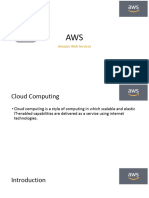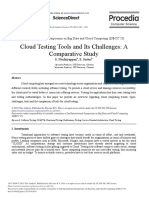0% found this document useful (0 votes)
63 views9 pagesCloud Computing
Cloud computing provides on-demand access to computing resources via the internet, with key types including SaaS, PaaS, and IaaS. Amazon Web Services (AWS) is a leading cloud platform offering over 200 services globally, known for its user-friendliness, flexibility, security, and cost-effectiveness. Despite its advantages, AWS faces challenges such as a lack of skilled professionals and price variations.
Uploaded by
loganathanprem65Copyright
© © All Rights Reserved
We take content rights seriously. If you suspect this is your content, claim it here.
Available Formats
Download as DOCX, PDF, TXT or read online on Scribd
0% found this document useful (0 votes)
63 views9 pagesCloud Computing
Cloud computing provides on-demand access to computing resources via the internet, with key types including SaaS, PaaS, and IaaS. Amazon Web Services (AWS) is a leading cloud platform offering over 200 services globally, known for its user-friendliness, flexibility, security, and cost-effectiveness. Despite its advantages, AWS faces challenges such as a lack of skilled professionals and price variations.
Uploaded by
loganathanprem65Copyright
© © All Rights Reserved
We take content rights seriously. If you suspect this is your content, claim it here.
Available Formats
Download as DOCX, PDF, TXT or read online on Scribd
/ 9























































































